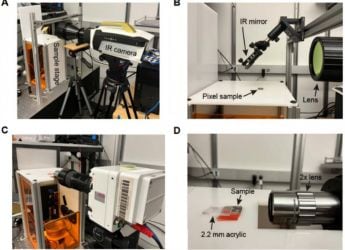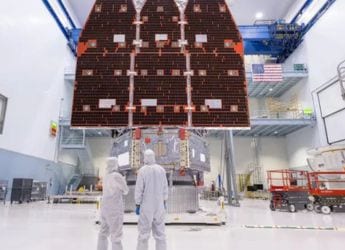- Home
- Science
- Science News
- NASA's MAVEN Spacecraft Marks 4 Years in Mars Orbit With a Selfie
NASA's MAVEN Spacecraft Marks 4 Years in Mars Orbit With a Selfie

Photo Credit: University of Colorado/NASA
This image is a composite selfie taken by MAVEN's Imaging Ultraviolet Spectrograph instrument
NASA's MAVEN spacecraft released a selfie image of the spacecraft at Mars, celebrating its four years in orbit studying the upper atmosphere of the Red Planet.
MAVEN'S selfie image looks at ultraviolet wavelengths of sunlight reflected off of components of the spacecraft.
The image was obtained with the Imaging Ultraviolet Spectrograph (IUVS) instrument that normally looks at ultraviolet emissions from the Martian upper atmosphere, the US space agency said in a statement.
"MAVEN has been a tremendous success," said Bruce Jakosky, MAVEN principal investigator from the University of Colorado, Boulder.
"The spacecraft and instruments continue to operate as planned, and we're looking forward to further exploration of the Martian upper atmosphere and its influence on climate," Jakosky added.
The IUVS instrument is mounted on a platform at the end of a 1.2-m boom (its own "selfie stick"), and by rotating around the boom can look back at the spacecraft.
The selfie was made from 21 different images, obtained with the IUVS in different orientations, that have been stitched together.
In the selfie image, lines are sketched in to show approximately where components of the spacecraft are that were not able to be imaged due to the limited motion of the instrument around its support boom.
Thrusters can be seen at the lower left and right, the Electra communications antenna at the bottom toward the left, the magnetometer and sun sensor at the end of the solar-panels at the upper left, the tip of the communications antenna at the top middle.
In addition, the shadow of the IUVS and of its support boom can be seen down the middle of the spacecraft body.
MAVEN mission was launched on November 18, 2013, and went into orbit around Mars on September 21, 2014.
Currently, the spacecraft carries out about one relay pass per week with one of the rovers. This number will increase after NASA's InSight mission lands on Mars in November, NASA said.
In 2019, engineers will initiate an aerobraking manoeuvre by skimming the spacecraft through Mars' upper atmosphere to slow it.
This will reduce the highest altitude in MAVEN's orbit to enhance its ability to serve as a communications relay for data from rovers on the surface, NASA noted.
Get your daily dose of tech news, reviews, and insights, in under 80 characters on Gadgets 360 Turbo. Connect with fellow tech lovers on our Forum. Follow us on X, Facebook, WhatsApp, Threads and Google News for instant updates. Catch all the action on our YouTube channel.
Related Stories
- Samsung Galaxy Unpacked 2025
- ChatGPT
- Redmi Note 14 Pro+
- iPhone 16
- Apple Vision Pro
- Oneplus 12
- OnePlus Nord CE 3 Lite 5G
- iPhone 13
- Xiaomi 14 Pro
- Oppo Find N3
- Tecno Spark Go (2023)
- Realme V30
- Best Phones Under 25000
- Samsung Galaxy S24 Series
- Cryptocurrency
- iQoo 12
- Samsung Galaxy S24 Ultra
- Giottus
- Samsung Galaxy Z Flip 5
- Apple 'Scary Fast'
- Housefull 5
- GoPro Hero 12 Black Review
- Invincible Season 2
- JioGlass
- HD Ready TV
- Laptop Under 50000
- Smartwatch Under 10000
- Latest Mobile Phones
- Compare Phones
- Jolla Phone
- Realme P4x 5G
- OnePlus Ace 6T
- Nubia Flip 3
- Nubia Fold
- OPPO A6x 5G
- Samsung Galaxy Z TriFold
- Poco F8 Ultra
- Asus ProArt P16
- MacBook Pro 14-inch (M5, 2025)
- OnePlus Pad Go 2
- Poco Pad M1
- Just Corseca Skywatch Pro
- Honor Watch X5
- Acerpure Nitro Z Series 100-inch QLED TV
- Samsung 43 Inch LED Ultra HD (4K) Smart TV (UA43UE81AFULXL)
- Asus ROG Ally
- Nintendo Switch Lite
- Haier 1.6 Ton 5 Star Inverter Split AC (HSU19G-MZAID5BN-INV)
- Haier 1.6 Ton 5 Star Inverter Split AC (HSU19G-MZAIM5BN-INV)

















